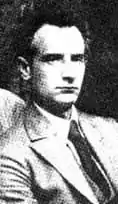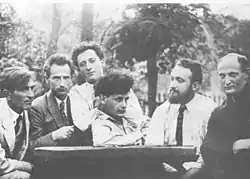Peretz Hirschbein
Peretz Hirshbein (Yiddish: פרץ הירשביין); 7 November 1880, Kleszczele, Grodno Governorate – 16 August 1948, Los Angeles) was a Yiddish-language playwright, novelist, journalist, travel writer, and theater director. Because his work focused more on mood than plot, he became known as "the Yiddish Maeterlinck". His work as a playwright and through his own short-lived but influential troupe, laid much of the groundwork for the second golden age of Yiddish theater that began shortly after the end of World War I. The dialogue of his plays is consistently vivid, terse, and naturalistic. Unusually for a Yiddish playwright, most of his works have pastoral settings: he had grown up the son of a miller, and made several attempts at farming.
Peretz Hirschbein | |
|---|---|
 | |
| Born | November 7, 1880 Kleszczele, Grodno Governorate |
| Died | August 16, 1948 (aged 67) Los Angeles |
| Spouse | Esther Shumiatcher-Hirschbein |
| Children | 1 |
Biography
He was born in Kleszczele in Grodno Governorate (present-day Podlaskie Voivodeship, Poland) where he was educated initially by local tutors, before he eventually made his way to Grodno and then Vilna, where he joined a circle of yeshiva students who studied the Bible, Hebrew grammar, and Jewish history together. Hirshbein began giving Hebrew lessons to support himself while publishing Hebrew poetry and writing Yiddish stories. He also began to shift from writing lyrical poetry to naturalist drama, starting with Miryam (1905), which he first wrote in Hebrew, later translated into Yiddish, and later still revised in Yiddish under the title Barg arop (Downhill). During the early 1900s, Hirshbein continued writing naturalist dramas in Hebrew, including Nevelah (Carcass), which in Yiddish (Di neveyle) became one of Hirshbein's most successful works. Olamot bodedim (Lonely Worlds; 1906) marked a new symbolist phase in his career, as well as the end of his practice of writing originally in Hebrew. His symbolist Yiddish plays of this period include the one-act Kvorim-blumen (Grave Blossoms), Di erd (The Earth), In der finster (In the Dark), and Der tkies-kaf (The Handshake). He was instrumental in the revival of Yiddish theater in Russia shortly after the 1904 lifting of the 1883 ban on theatrical performances in that language. Prior to his involvement in Yiddish theater, he wrote several plays in Hebrew; these were published in the periodical Hazman, but there was no audience at that time for Hebrew-language theater.
In 1908 Hirshbein moved to Odessa, where he wrote the drama Yoyel (Joel). Soon afterward, Af yener zayt taykh (On the Other Side of the River), his first Yiddish drama, was produced in Russian in Odessa. In autumn of the same year, Hirshbein, encouraged by Bialik and by students from an acting conservatory in Odessa, founded the theater company that became known as the Hirshbein Troupe. It was the first Yiddish company to devote itself exclusively to "better" Yiddish theater. The troupe toured through Imperial Russia for two years, staging his own plays, as well as works by Sholem Asch, David Pinski, Sholem Aleichem, and Jacob Gordin, as well as translations of plays by Semen Iushkevich and Herman Heijermans. The troupe's high literary standards and high standards of ensemble acting strongly influenced the later Vilna Troupe and Maurice Schwartz's New York-based Yiddish Art Theater.

The troupe disbanded in 1910 for financial reasons, at which point Hirschbein published what Jacob Glatshteyn (In tokh genumen [Sum and Substance], 1976, p. 77) has called "the four greatest plays in the Yiddish repertoire": A farvorfn vinkl (A Forsaken Corner; 1912), Di puste kretshme (The Empty [Deserted] Inn; 1913, written in America), Dem shmids tekhter (The Blacksmith's Daughters; 1918) and Grine felder (Green Fields; 1916). In these and other dramas, Hirshbein abandoned symbolism and returned to his rural roots, dramatizing the lives and loves of rural Jews. The understated quality of these works appealed to directors including Maurice Schwartz and Jacob Ben-Ami, and they became regular productions in the repertoire of artistically ambitious Yiddish theaters. His popularity extended to other cultures and genres, and his plays were performed in Russian, Hebrew, English, German, Spanish, and French. Indeed, the 1937 American film Grine felder (Green Fields), based on Hirshbein's play, is among the most beloved of all Yiddish films, and the play continues to be often anthologized and staged.
Hirshbein traveled extensively; in 1911 alone, he visited Vienna, Paris, London, and New York City. For a while in 1912, he tried farming in New York's Catskills (later, home to the Borscht Belt); he then returned briefly to Russia, and went from there to Argentina for another attempt at farming, this time in a Jewish agricultural colony. At the start of World War I he was en route to New York on a British ship, which was sunk by a German cruiser. He was briefly taken captive, then let off in Brazil, from where he eventually reached New York. He spent the succeeding decades traveling, accompanied by his wife, Yiddish poet Esther Shumiatcher-Hirschbein, and publishing both fiction and nonfiction based on his trips.
Hirschbein's son, Omus Hirschbein, a classical music administrator, was born in New York in 1934 just before the family moved to Los Angeles. Hirschbein suffered from amyotrophic lateral sclerosis (Lou Gehrig's Disease) for the last three years of his life. He died August 16, 1948, in Los Angeles.
Works
Yiddish-language plays, unless otherwise noted.
- Miriam (a.k.a. Downhill, 1905, in Hebrew)
- Oif Yener Zeit Taikh (On the Other Side of the River, 1906)
- Die Erd (Earth, 1907)
- Tkias Kaf (Contract, a.k.a. The Agreement 1907)
- Oifn Shaidveg (Parting of the Ways, 1907)
- Neveyle (Carcass, 1908)[1]
- Die Puste Kretshme (The Haunted Inn, 1912)
- A farvorfen Vinkel (A Neglected Nook or A Hidden Corner, 1912)
- Griene Felder (Green Fields, 1916)
- Dem Schmids Tekhter (The Smith's Daughters, 1918 or earlier)
- Where Life Ends
- Joel
- The Last One
- The Infamous
- A Lima Bean
- Roite Felder (Red Fields, 1935, novel)
- Hitler's Madman (screenplay for 1943 English-language film, the American debut of director Douglas Sirk)
References
- Zylbercweig, Zalmen (1931). "Hirshbein, Perets" (in Yiddish). Leksikon fun yidishn teater [Lexicon of the Yiddish Theatre]. Vol. 1. Warsaw: Farlag Elisheva. Columns 613-628; here, 614.
- "Hirshbeyn, Perets" (1960). In: Leksikon fun der nayer yidisher literatur [Biographical Dictionary of Modern Yiddish Literature]. Vol. 3. New York: Alveltlekhn yidishn kultur-kongres [Congress for Jewish Culture]. Columns 147–158.
- Liptzin, Sol (1972). A History of Yiddish Literature, Middle Village, NY: Jonathan David Publishers. ISBN 0-8246-0124-6. 82 et. seq.
External links
- Works by or about Peretz Hirschbein at Internet Archive
- Peretz Hirshbein at IMDb
- Papers of Peretz Hirschbein.; RG 833; YIVO Institute for Jewish Research, New York, NY.